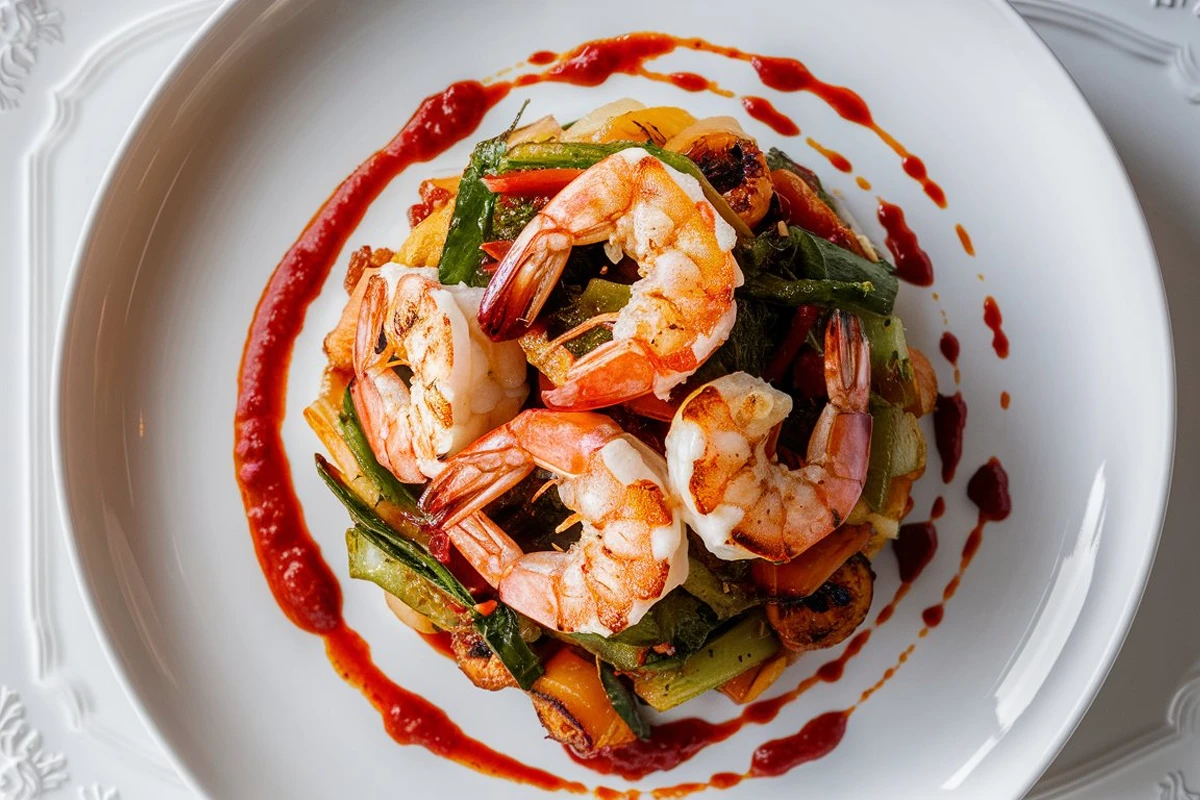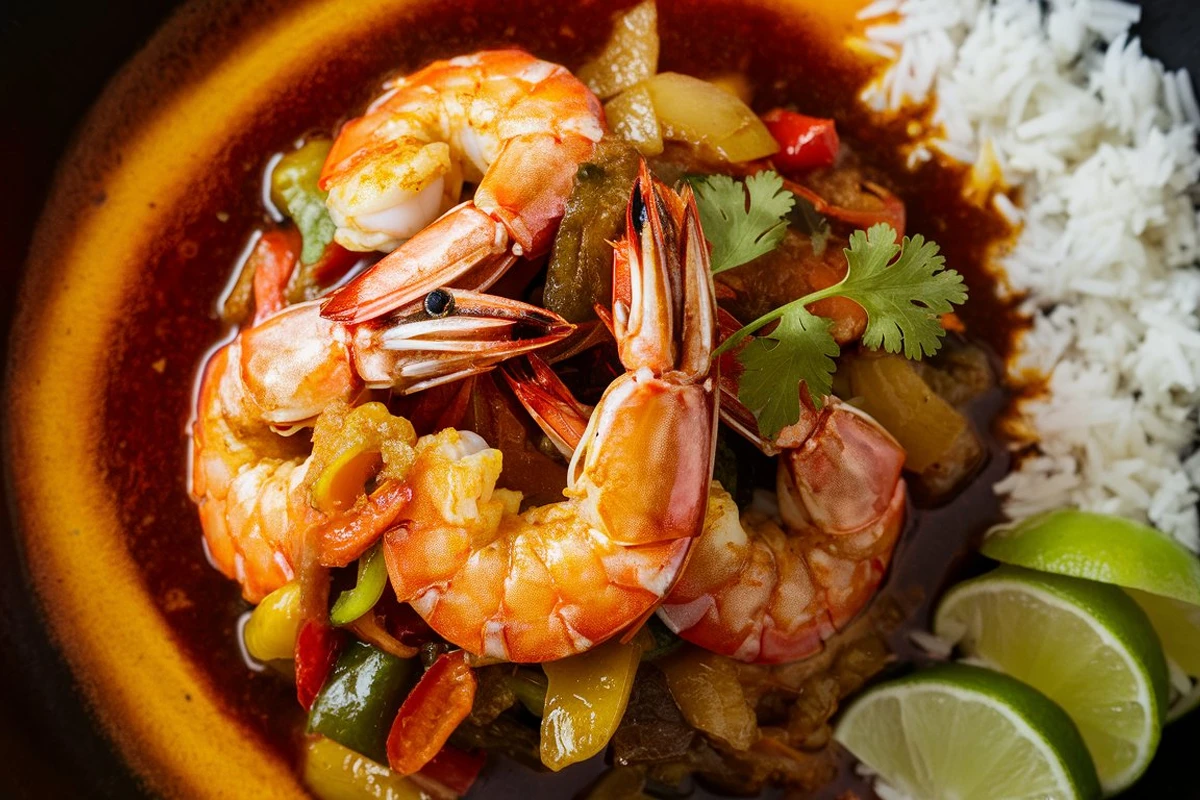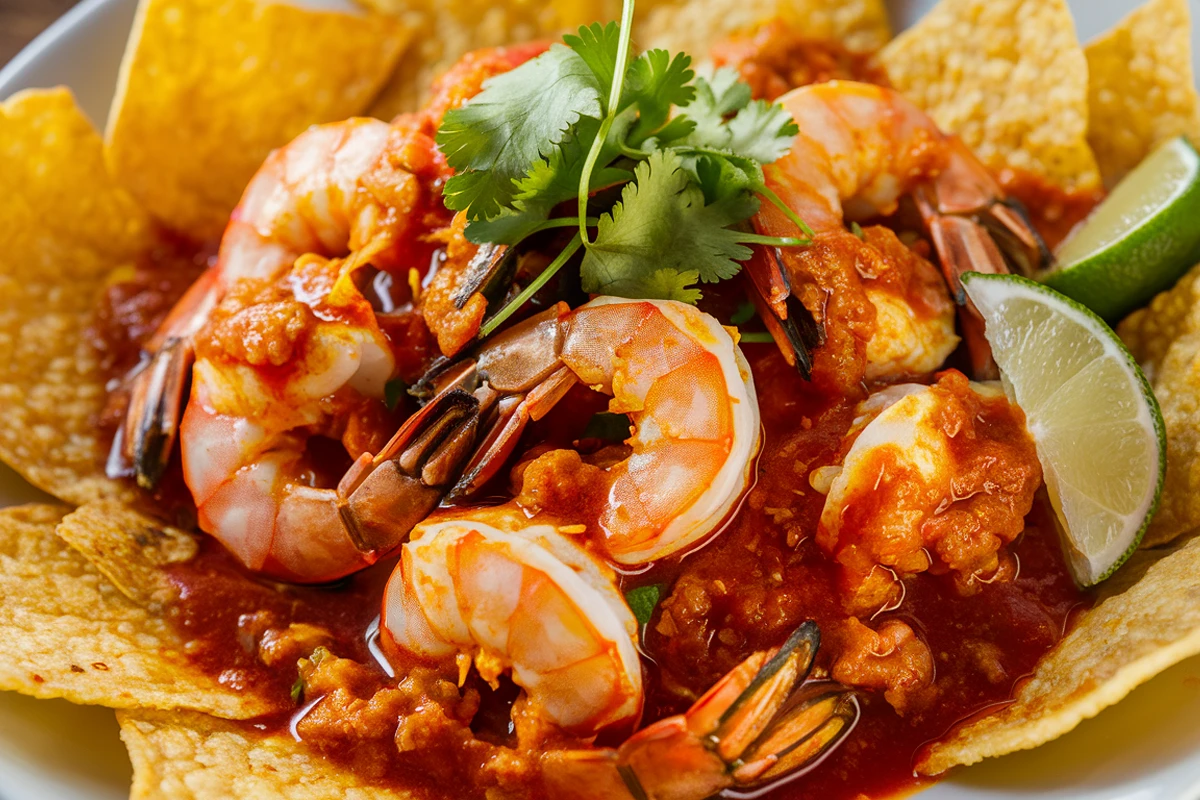Introduction to Camarones a la Diabla
What Are Camarones a la Diabla?
Camarones a la Diabla, or Diablo Shrimp, is more than just a meal; it’s a vibrant expression of Mexican cooking. This dish features plump shrimp smothered in a rich, spicy sauce made from a blend of chile peppers. The name itself, translating to “deviled shrimp,” hints at the level of heat you can expect. It’s a popular choice in Mexican restaurants and among home cooks who enjoy a zesty flavor profile.
Popularity in Mexican Cuisine
Why, you might wonder, has this dish gained such a following? Simply put, it perfectly balances heat and flavor. Moreover, in Mexico, Camarones a la Diabla highlights local ingredients, delivering a spicy punch that awakens taste buds with chile peppers.
A Brief History of the Dish
The origins of Camarones a la Diabla are as rich as its flavors. While the exact history remains somewhat nebulous, experts believe that it originated in coastal regions of Mexico, where seafood is abundant. Over time, it has evolved into a beloved dish throughout the country, with each region adding its unique twist. Whether you’re dining in the bustling streets of Mexico City or along the serene beaches of the Yucatan, Camarones a la Diabla remains a testament to the creativity and culinary traditions of Mexican cuisine.
Ingredients and Cooking Tools Needed
Essential Ingredients for Camarones a la Diabla
To whip up a batch of Camarones a la Diabla, you’ll need several key ingredients that are vital for achieving the authentic fiery flavor. Here’s what to gather:
- Large raw shrimp: Fresh or frozen, make sure they are peeled and deveined. The size of the shrimp can vary, but larger shrimp tend to provide a juicier bite.
- Guajillo chiles: These are mild to medium hot and offer a smoky flavor, essential for the base of the sauce.
- Árbol chiles: These add the extra kick, dialing up the heat for that devilish quality the dish is known for.
- Roma tomatoes: Their firmness and mild acidity balance the heat of the chiles.
- Garlic and onions: Fundamental for adding depth to the sauce’s flavor profile.
- Salt: Enhances all the flavors in the dish.
Substitutions to Consider
While recommending the traditional ingredients, here are a few substitutions for those aiming to adjust the recipe to their taste or availability.
- Chipotle or pasilla chiles can be used in place of guajillo chiles for a different level of smokiness and heat.
- Bell peppers blended with a bit of hot paprika might substitute for chile peppers if you’re aiming for less heat.
Cooking Tools Required
Gathering the right tools can make the process of cooking Camarones a la Diabla much smoother. Here’s what you’ll need:
- Blender or food processor: Essential for pureeing the chiles and tomatoes into a smooth sauce.
- Large skillet or sauté pan: This will be used to cook the shrimp and simmer the sauce.
- Measuring spoons and cups: For precise ingredient measurement, ensuring the balance of flavors is just right.
- Slotted spoon and spatula: Useful for handling the shrimp and stirring the sauce.
Step-by-Step Cooking Guide of Camarones a la Diabla
Preparing the Shrimp
Before you start cooking, make sure your shrimp are ready to go. Before use, make sure frozen shrimp are completely thawed to ensure optimal cooking results. Here’s how to prepare them:
- Give the shrimp a quick rinse under cold water, then gently blot them dry with paper towels.
- Peel and devein the shrimp if they aren’t already. Leaving the tail on is optional and can make for a nicer presentation.
Making the Diabla Sauce
The sauce is the soul of the Camarones a la Diabla. It’s where all the fiery flavor is developed. Follow these steps to create the perfect Diabla Sauce:
- Rehydrate the chiles: In a medium bowl, cover the guajillo and árbol chiles with hot water. Allow them a 15-minute soak to soften up.
- Prepare the sauce base: While the chiles are soaking, roughly chop the Roma tomatoes, garlic, and onions.
- Blend the ingredients: Drain the chiles and transfer them to a blender. Add the chopped tomatoes, garlic, onion, and a teaspoon of salt. Blend until the mixture is completely smooth. If the sauce is too thick, add a little water to achieve a pourable consistency.
- Taste and adjust seasoning: It’s crucial to taste your sauce at this point. If it’s too spicy, you can add another tomato to mellow it down. If it’s not spicy enough, consider adding another árbol chile.
Cooking the Shrimp with the Sauce
Now that your Diabla Sauce is ready, it’s time to bring everything together:
- Heat the oil: In a large skillet or sauté pan, heat the olive oil over medium-high heat.
- Introduce the shrimp into the sizzling pan. Cook for about 1 minute per side or until they start to turn pink.
- Add the sauce: Pour the Diabla Sauce over the shrimp. Stir well to ensure all the shrimp are evenly coated.
- Simmer: Reduce the heat to medium and allow the shrimp to simmer in the sauce for 3 to 5 minutes, or until the sauce is bubbling and the shrimp are cooked through.
- Final touches: Taste the dish once more, and adjust the seasoning with salt or a squeeze of lime juice for an extra zing.
Serve your Camarones a la Diabla hot, garnished with fresh cilantro if desired. This dish pairs wonderfully with a side of Mexican rice or a fresh salad for a lighter touch.
Nutritional Information of Camarones a la Diabla
Health Benefits of Key Ingredients
Camarones a la Diabla isn’t just delicious; it’s also packed with nutrients that are beneficial for your health. Let’s break down the main components:
- Shrimp: High in protein and low in calories, shrimp is a great source of selenium, a powerful antioxidant that helps combat inflammation and promotes heart health.
- Chile Peppers: Rich in vitamins A and C, chile peppers can boost your immune system and may help to reduce cholesterol levels due to their capsaicin content, which also aids in metabolism.
- Tomatoes: A good source of vitamin C, potassium, folate, and vitamin K, tomatoes are renowned for their high antioxidant content, particularly lycopene, which has been linked to many health benefits including reduced risk of heart disease and cancer.
- Garlic and Onions: Known for their heart health benefits, these ingredients help lower blood pressure and improve cholesterol levels, while also offering anti-inflammatory properties.
Caloric and Nutritional Breakdown
A typical serving of Camarones a la Diabla provides a balanced mix of nutrients, ideal for those mindful of their diet. Here’s what a typical serving (approximately 200 grams) contains:
- Calories: About 250-300, making it a low-calorie option ideal for weight management.
- Proteins: Approximately 20-25 grams, essential for muscle repair and growth.
- Fats: Around 10-15 grams, predominantly healthy fats from the olive oil and shrimp.
- Carbohydrates: Minimal; this dish is predominantly protein and fat, with some carbs coming from the vegetables.
Customizing for Dietary Needs
Camarones a la Diabla is inherently gluten-free and low carb, which suits a variety of dietary preferences including paleo and ketogenic diets. Additionally, for those on a low-sodium diet, adjust salt in the recipe according to taste and health needs.
Variations of the Dish
Regional Variations Within Mexico
Across Mexico, Camarones a la Diabla is adapted to suit local tastes and available ingredients, leading to delightful regional variations. For instance:
- Coastal regions like Veracruz or Yucatan might add a touch of citrus to the sauce to complement the seafood’s natural flavors, infusing the dish with a subtle brightness.
- Inland areas, such as Mexico City, often opt for a smokier version, using chipotle chiles in addition to or instead of guajillo chiles, which adds depth to the flavor profile.
Creative Twists to Personalize the Dish
Don’t hesitate to add your personal touch to Camarones a la Diabla to fit your taste preferences or dietary needs:
- For a milder version: Reduce the number of árbol chiles, or substitute them with a milder variety like ancho chiles, which are less intense but still flavorful.
- Add vegetables: Incorporate bell peppers, zucchini, or mushrooms to the skillet when sautéing the shrimp, adding texture and nutrients.
- Vegan option: Substitute shrimp with firm tofu or tempeh, frying until golden before adding the diabla sauce for a plant-based take on the classic.
Exploring these variations can render Camarones a la Diabla a versatile dish that never becomes boring, enabling chefs to tailor it to different taste preferences and dietary restrictions.
Experiment with Ingredients
Creativity in the kitchen means you can experiment with various ingredients that may not be traditional but can enhance the dish in unique ways. For instance:
- Add fruit: A small amount of chopped pineapple or mango can add a sweet contrast to the spicy sauce, creating a more complex flavor palette.
- Creamy element: Stir in a dollop of sour cream or Greek yogurt into the sauce to temper the heat and add a creamy texture.
Serving Suggestions of Camarones a la Diabla
Best Sides and Drinks to Complement Camarones a la Diabla
The fiery nature of Camarones a la Diabla calls for side dishes that can balance its heat while enhancing the meal’s overall experience. Consider these options:
- Mexican Rice: A classic side, Mexican rice, with its mild tomato flavor and colorful mix of vegetables, provides a soothing contrast to the spicy shrimp.
- Cilantro Lime Rice: For a fresher, zestier side, cilantro lime rice adds a bright note that complements the dish’s robust flavors.
- Grilled Vegetables: Grilled vegetables such as bell peppers, onions, and zucchini add smokiness and crunch, complementing the tender shrimp perfectly.
- Warm Corn Tortillas: Essential for any Mexican meal, corn tortillas can be used to scoop up the shrimp and sauce, turning the dish into a delicious taco filling.
For drinks, opt for beverages that can cool down the palate:
- Virgin Margarita: A chilled, lime-rich virgin margarita can provide a refreshing counterbalance to the spice.
- Agua Fresca: Flavors like cucumber, lime, or watermelon in an agua fresca make it an excellent choice for soothing the heat.
Tips for Presentation
How you present Camarones a la Diabla can enhance the dining experience. Consider these suggestions to elevate the visual appeal of your dish:
- Colorful Garnishes: Sprinkle chopped cilantro, diced red onion, or a few lime wedges on top of the shrimp to add color and freshness.
- Serve in a Traditional Clay Pot: If available, serve the shrimp in a clay pot or a cazuela to give your presentation an authentic touch.
- Layer the Flavors: Arrange the shrimp over a bed of rice or alongside a vegetable medley to create a visually appealing and balanced plate.
Presentation not only makes the meal more inviting but also sets the stage for a memorable dining experience. By combining these serving suggestions and presentation tips, you can elevate Camarones a la Diabla from a simple home-cooked meal to a festive and flavorful feast.
FAQs
What is Diabla Sauce made of?
Crafted from a blend of guajillo and árbol chiles, Diabla Sauce involves soaking the chiles before pureeing them with Roma tomatoes, garlic, and onions. To elevate the spicy and robust flavor of this fiery mixture, chefs season it with salt, making it perfect for coating succulent shrimp.
How are the shrimp cooked?
Firstly, the shrimp are sautéed briefly in hot oil, usually for about one minute on each side, until they start to turn pink. Next, chefs pour Diabla Sauce over shrimp, simmering until the sauce bubbles and the shrimp are thoroughly cooked.
What is a shrimp?
A shrimp is a small, decapod crustacean found primarily in marine environments. Renowned for its sweet, delicate flavor, shrimp is a popular seafood choice globally, utilized in various dishes from salads to main courses.
What is the difference between shrimp and prawns?
Despite the frequent interchangeability of the terms shrimp and prawns, they actually denote distinct species. Prawns, characterized by their larger size and longer legs, inhabit freshwater environments. Conversely, shrimp, which are generally smaller with shorter legs, thrive in saltwater habitats. Culinary enthusiasts highly esteem both for their tender meat and adaptability in various recipes..
Conclusion
In wrapping up, Camarones a la Diabla stands out as a remarkable dish that brilliantly encapsulates the essence of Mexican cuisine. Packed with flavor, it marries the zest of chile peppers with the sweetness of shrimp in a dance of spice and succulence. For those eager to delve into authentic Mexican cooking, this dish offers a perfect starting point.
Moreover, as you’ve learned, Camarones a la Diabla is adaptable. Whether you soften the spice for a milder palate or embrace the heat with additional árbol chiles, you can tailor the dish to suit any taste. Additionally, its nutritional benefits are impressive, providing a healthy dose of proteins and antioxidants without compromising on taste.
Furthermore, the versatility of Camarones a la Diabla extends to its serving options. Whether paired with a side of aromatic Mexican rice or wrapped in a warm tortilla, it promises a satisfying meal. The tips for presentation ensure each serving is as visually appealing as it is delicious.
Lastly, embrace the culinary adventure that Camarones a la Diabla presents. By experimenting with the ingredients and techniques shared here, you’re sure to enrich your cooking repertoire. Each bite invites you to explore further the rich and vibrant flavors of Mexico. So, don your chef’s hat, fire up the stove, and prepare to impress at your next meal with this spicy, scrumptious delight.



